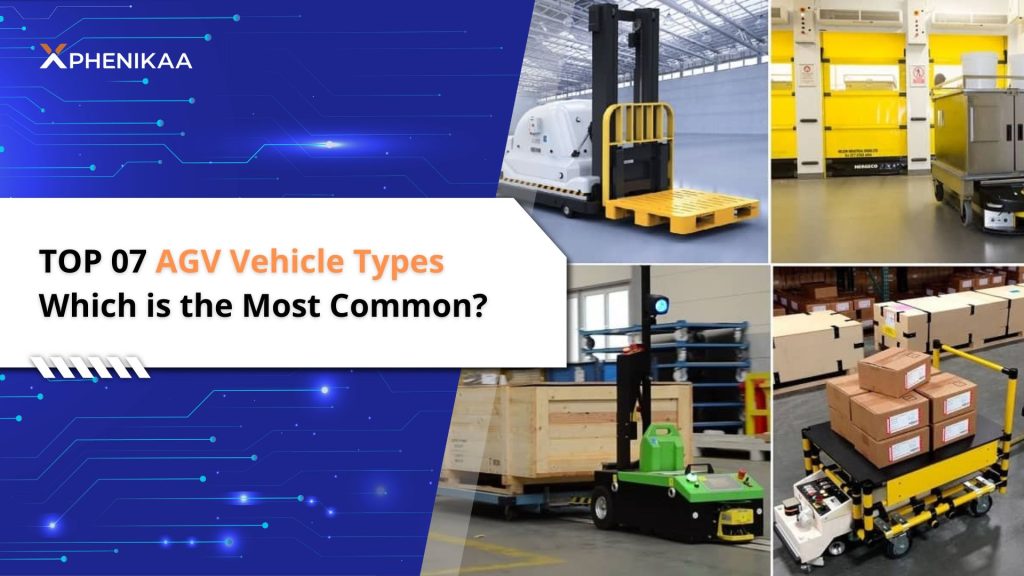AGV, or Automated Guided Vehicles, is now well known for providing efficient, safe, and automated solutions for material handling in different industries. But with so many AGV vehicle types available, how do you know which one is right for your operation? More importantly, which type of AGV vehicle is the most common across industries? In this article, Phenikaa-X will explore 07 most common AGV vehicle types, their fields of work with a comparison chart and analysis of the most prevalent type based on usage trends and industry data.
1. List of AGV Vehicle Types and Their Fields of Work
AGVs come in various forms, each designed to meet specific operational needs. Below, we’ll break down seven prominent AGV vehicle types and the fields where they excel.
1.1. Automated Guided Cart (AGC)
Automated Guided Cart (AGC) is a compact and straightforward type of AGV vehicle. This robot has a simple and efficient design, with a flat surface to carry stuff on its back. AGC excels at moving small to medium loads, some can carry up to 1-2 tons. AGC requires no complicated installation, making them a popular choice among AGV vehicle types for repetitive, short-distance tasks.
Not just in industries, AGC are tested on delivering supplies in hospitals, supporting medical staff with simple tasks. With multiple designs fulfilling different field requirements, you can expect this type of AGV to continue to support humans in the future.

- Fields of Work:
- Automotive Industry: Used to transport components between assembly stations.
- Warehousing: Moves small loads or carts in distribution centers.
- Hospitals: Delivers medical supplies, linens, or food trays.
- Design: Identifiable with a Flat on the surface. Normally the robot has a slender design or follows a rectangular block shape.
- Key Features: Simple design, easy to use and ideal for repetitive, short-distance tasks.
- Pricing: Affordable around $16,000 – $20,000
You can check Phenikaa-X’s AGV products here for further detail about AGV technology.
1.2. Forklift AGV
Forklift AGV is widely considered as a staple in warehouses and manufacturing facilities. They are a versatile and powerful type of AGV vehicle equipped with forks or lifting masts. This design allowing them to replace traditional forklifts with the ability to lift and stack pallets makes them indispensable for vertical storage and retrieval tasks.
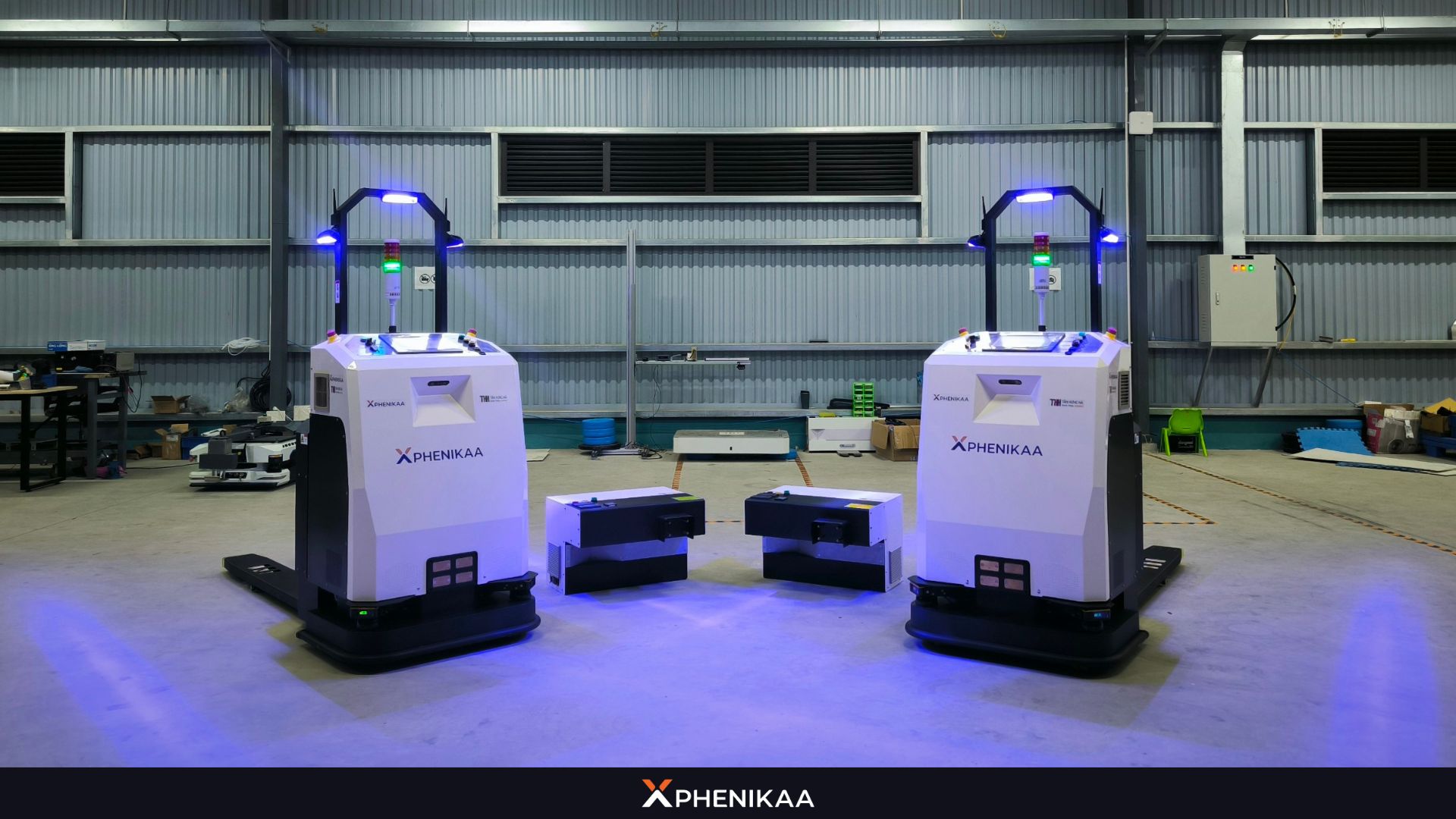
Same as other AGV, Forklift AGV also uses advanced navigation systems like laser or vision guidance for precision in dynamic environments. They streamline tasks like loading trucks or retrieving items from racks, offering a reliable solution for vertical storage needs without human intervention.
- Fields of Work:
- Warehousing: Stacks pallets and retrieves items from racks.
- Manufacturing: Feeds production lines with raw materials or moves finished goods.
- Distribution Centers: Handles loading/unloading of trucks.
- Key Features: High lifting capacity (some variants can lift up to 10,000 kg), precise navigation and suited for vertical storage environments.
- Design: Have forks or lifting masts, allow robots to carry pallets.
- Pricing: $50,000 – $100,000
1.3. Tugger (Towing) AGV
Tugger AGV, also known as towing AGV or Tugger Train, is a highly efficient type of AGV vehicle built to pull multiple carts or trailers in a train-like formation. This AGV comes with a towing hook, designed for bulk material transport. They can tow several tons of goods over longer distances, reducing the number of trips required, making them ideal for large-scale manufacturing or logistics.

The upside of Towing AGV is the ability to take advantage of existing carts, which might help business owners with tons of budget. Although the lack of lifting capabilities, their ability to handle large volumes cost-effectively makes them a go-to choice for large-scale operations.
- Fields of Work:
- Manufacturing: Transfers parts to assembly lines.
- Logistics: Moves goods between warehouse zones.
- Automotive: Hauls components in large plants.
- Design: Similar to other AGV, but have a towing hook attached on the back.
- Key Features: High throughput (can tow several tons), cost-effective for bulk transport, and often used in fleets.
- Pricing: $30,000 – $70,000
1.4. Unit Load AGV
Unit Load AGV are workhorses for transporting palletized or discrete loads. Unlike Forklift AGV, they don’t lift loads off the ground. Instead, they design allowing them to carry loads on a flat platform in the back, which makes them require external equipment like conveyors for loading and unloading.
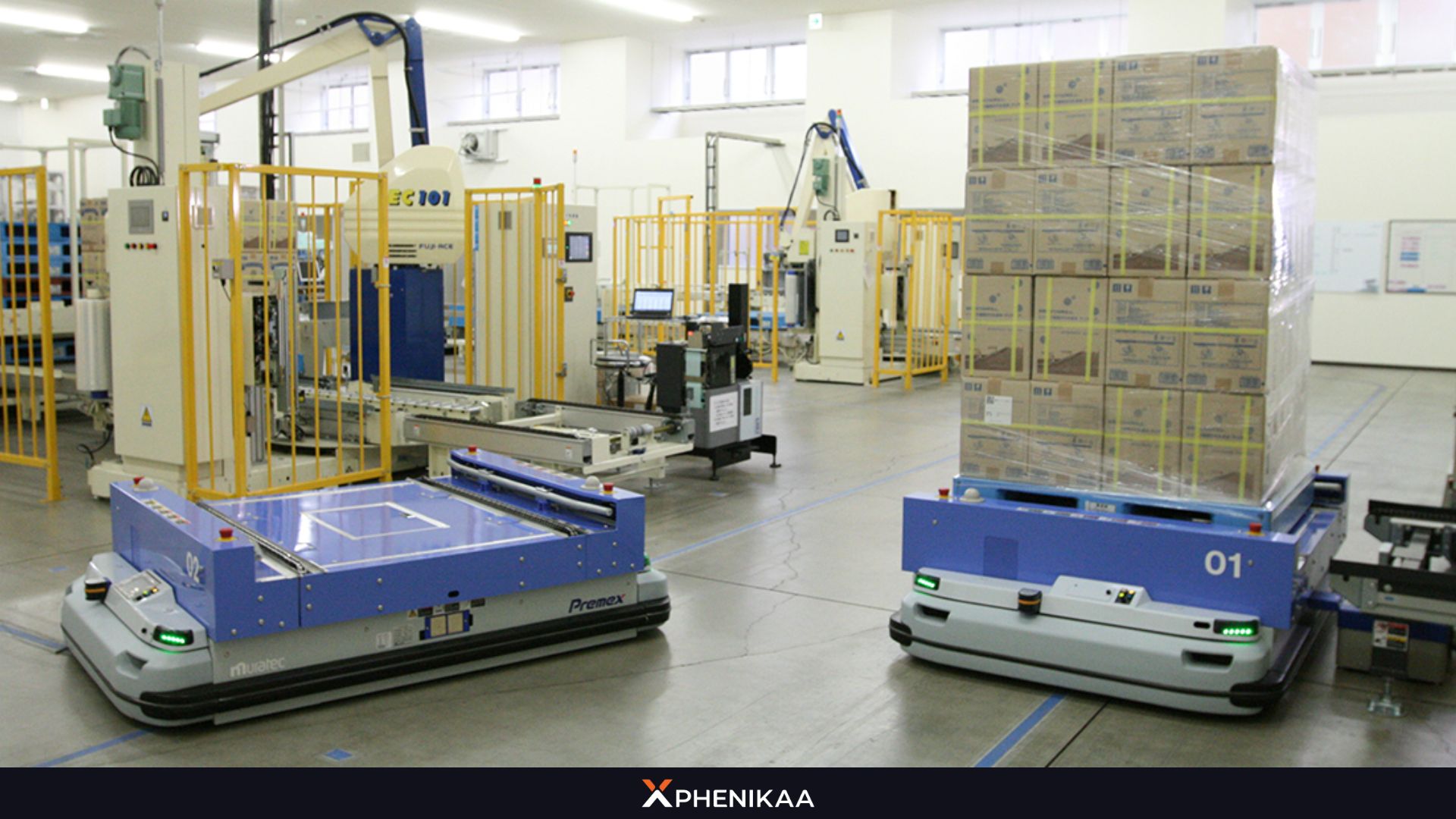
In trade off with that, the maximum payload capacities of Unit Load AGV can reach up to 3 tons, which is one of the highest weights an automobile vehicle can carry. This type of AGV vehicle is prevalent in warehousing, manufacturing, and industries like paper or steel mills, where consistent transport of heavy, uniform loads is essential.
- Fields of Work:
- Manufacturing: Transports raw materials or finished goods.
- Warehousing: Moves pallets to storage or shipping areas.
- Logistics: Moves goods between warehouse and production zones.
- Design: Have a loader or conveyor on its back.
- Key Features: Heavyload capable, versatile payload options, robust construction, and ideal for long-distance transport.
- Pricing: $40,000 – $80,000
1.5. Heavy Load AGV
Heavy Load AGV in conceptual design is quite the same as Unit Load AGV, but with much higher loads capable. Their high cost and specialized design make them less common but critical in industries with oversized payloads. Safety features, such as advanced sensors, are equipped to fulfill their operating conditions.
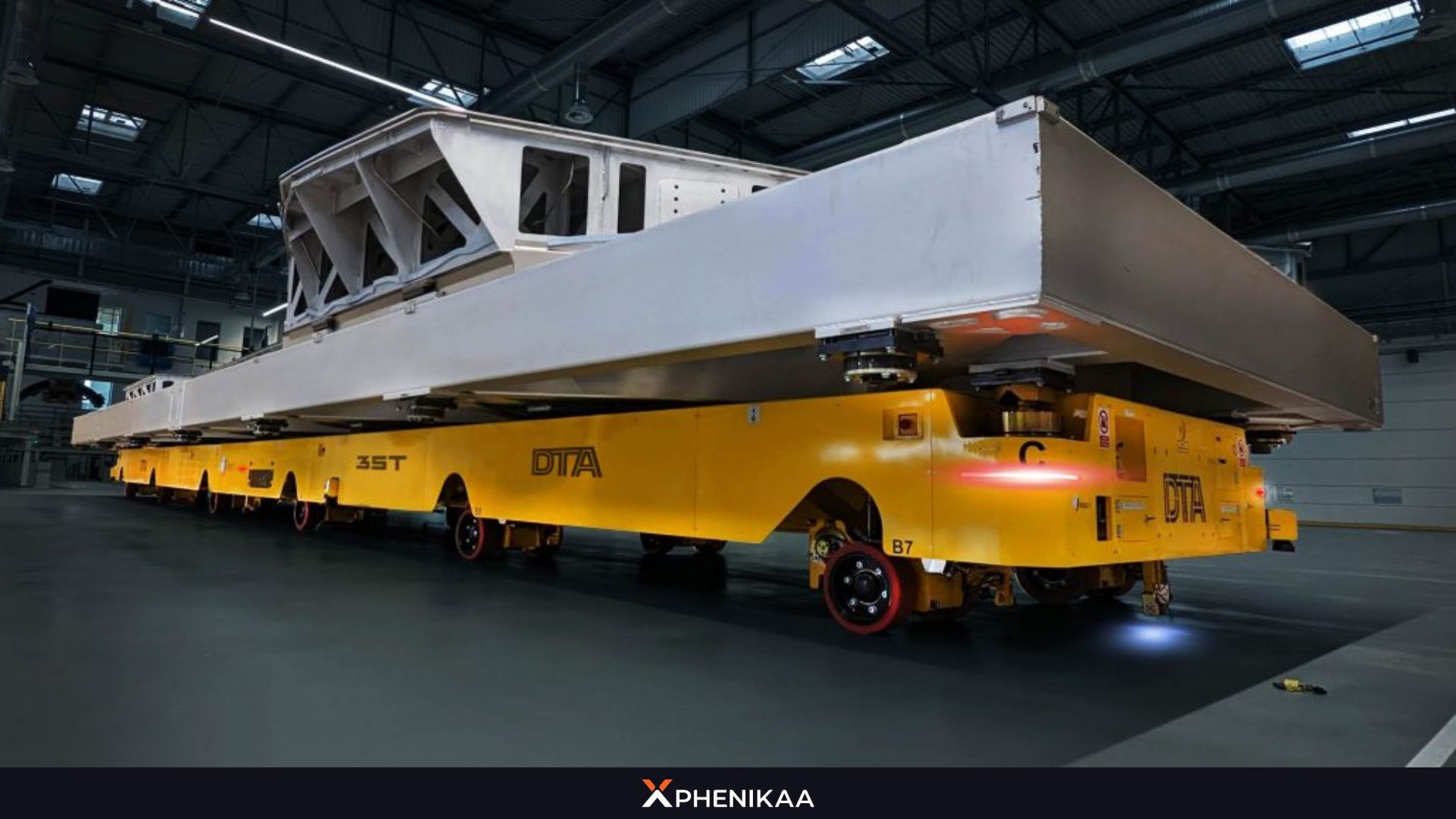
- Fields of Work:
- Heavy Industries: Transports massive rolls or slabs, Airplane components.
- Construction: Hauls heavy machinery parts.
- Key Features: High payload capacity, durable build and suited for harsh environments.
- Design: Similar to regular Unit Load AGV, but bigger in size and wider surface plate
- Pricing: $100,000+
1.6. Mini AGV (Small Load Carrier)
Away from big design, Mini AGV – also known as small load carriers, is a small-scale and compact AGV vehicle types designed for lightweight tasks. They’re a fast-growing category among AGV vehicle types, particularly in E-commerce fulfillment centers, electronics manufacturing, and most recently are trendy used in big hospitals.
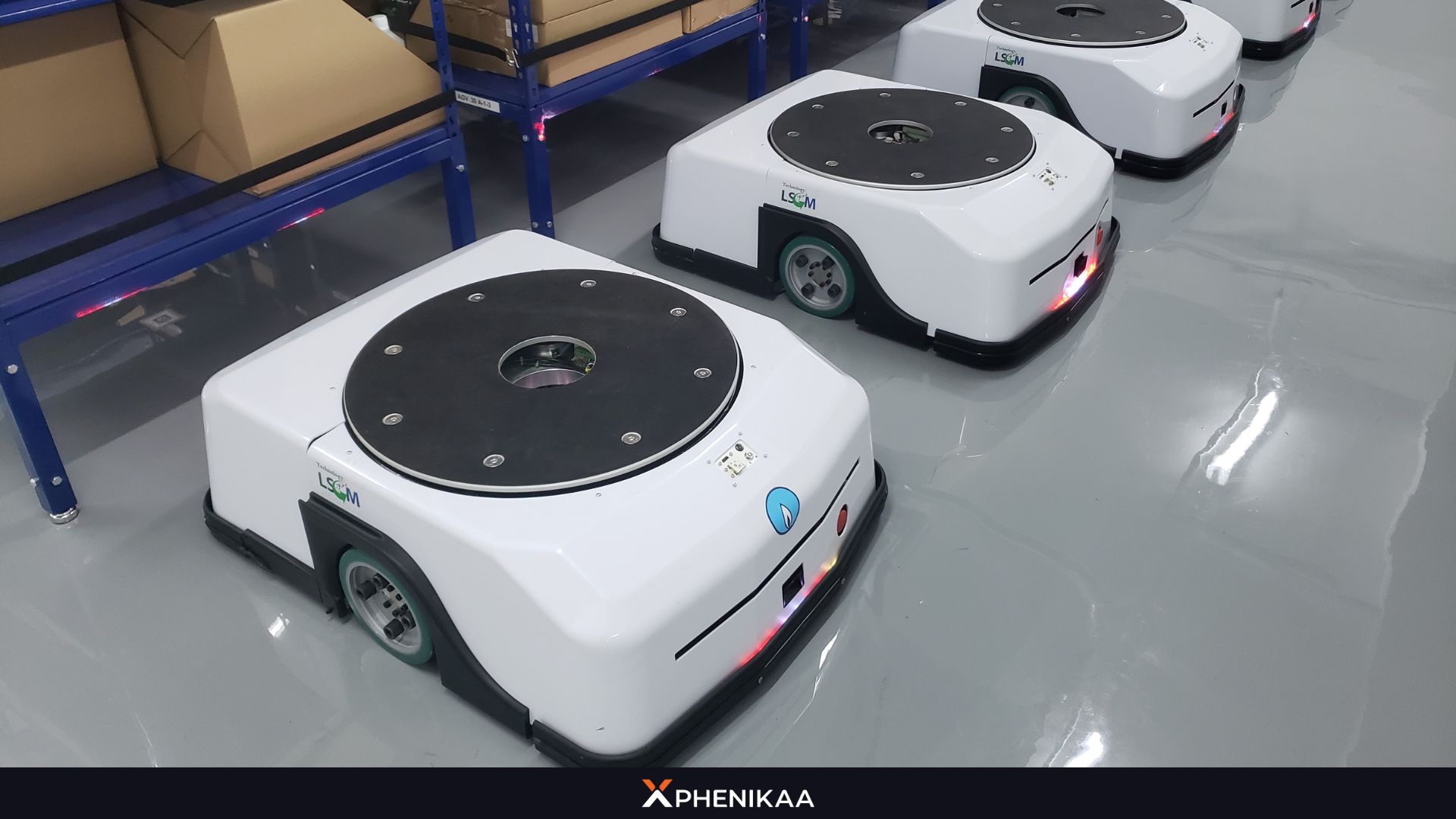
Their agility and low cost make them a growing trend, especially as online retail expands. However, their lightweight design limits them to less demanding tasks.
- Fields of Work:
- Light industrial: Carry product components and other light weight stuff.
- Hospitals: Delivers AGV Scissor Lifts blend transport with ergonomic positioning, making them unique in assembly lines.
- E-commerce: Transports bins in fulfillment centers.
- Key Features: Small, lightweight loads (typically under 60 kg) design for tight spaces or small industrials, and cost-effective for light-duty tasks.
- Design: Small, easy to move in small spaces.
- Pricing: $10,000 – $25,000
1.7. AGV Scissor Lifts
AGV Scissor Lifts blend transport with ergonomic positioning, making them unique in assembly lines. They’re less common due to their task-specific nature but invaluable in industries requiring precise height adjustments, such as automotive or aerospace manufacturing.
AGV Scissor Lifts are a unique and specialized type of AGV vehicle that combine material transport with vertical positioning capabilities. Equipped with a scissor mechanism, these AGVs can raise or lower loads – up to 3 tons – to specific heights (typically up to 2 meters) during transit or at workstations.
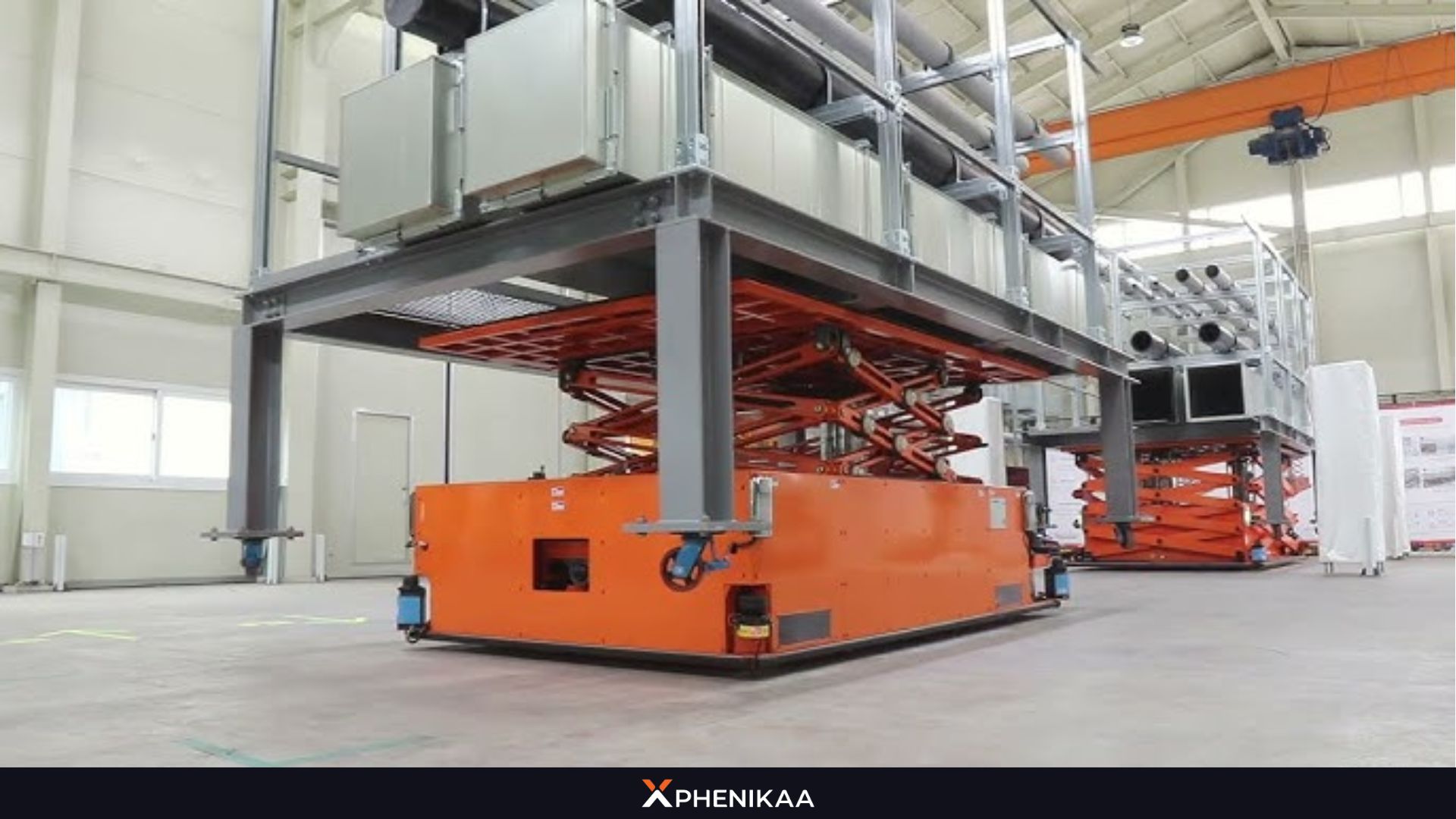
This AGV vehicle types is mostly used in manufacturing for assembly tasks, warehousing and aerospace for component positioning. They’re less common due to their task-specific nature but invaluable in industries requiring precise height adjustments.
- Fields of Work:
- Manufacturing: Positions large products for assembly
- Warehousing: Adjusts loads for ergonomic picking.
- Shipbuilding Industry and Aerospace construction: Aligns components during production.
- Design: Have a scissor lift built-in on its back with ergonomics design.
- Key Features: Lifting capability and integration with production workflows.
- Pricing: $60,000 – $120,000
2. Comparison Chart for AGV Vehicle Types
To better understand the differences between these AGV vehicle types, here’s a detailed comparison chart based on key factors like payload capacity, cost, flexibility, and common applications.
| AGV Type | Payload Capacity | Cost Range* | Flexibility | Navigation | Common Applications | Ease of Integration |
| Automated Guided Carts (AGCs) | Normally at 200-400kg. Can be up to 1-2 tons | $16,000 – $20,000 | High (simple routes) | Magnetic, Laser | Warehousing, Automotive | High |
| Forklift AGVs | 1,000 – 10,000 kg | $50,000 – $100,000 | Moderate (fixed paths) | Laser, Vision | Warehousing, Manufacturing | Moderate |
| Tugger AGVs | Several tons (towing) | $30,000 – $70,000 | High (multi-cart) | Magnetic, Laser | Manufacturing, Logistics | High |
| Unit Load AGVs | Up to 6,600 lbs | $40,000 – $80,000 | Moderate | Laser, Magnetic | Warehousing, Mills | Moderate |
| Heavy Load AGVs | 1+ ton as standard | $100,000+ | Low (specialized) | Laser, Inertial | Aerospace, Steel Industries | Low |
| Mini AGVs | Around 200kg or lower. | $10,000 – $25,000 | Very High (agile) | Vision, Magnetic | E-commerce, Hospitals | High |
| AGV Scissor Lifts | Up to 2 tons | $60,000 – $120,000 | Moderate (task-specific) | Laser, Vision | Manufacturing, Assembly | Moderate |
*The cost is an average number from different manufacturers. It is not representing the actual price of an AGV unit.
3. Which is The Most Common AGV Vehicle Types?
So, which type of AGV vehicle is the most common? Based on industry adoption, usage trends, and versatility, Tugger AGVs is currently the most common type being used widely around the world. Here’s why:
- Widespread Application: Tugger AGVs are deployed across manufacturing, logistics, and automotive sectors-some of the largest adopters of AGV technology. Their ability to tow multiple carts makes them a go-to solution for moving goods efficiently in large facilities.
- Cost-Effectiveness: Priced between $30,000 and $70,000, Tugger AGVs offer a strong balance of affordability and functionality, appealing to both small and large operations.
- High Throughput: Unlike Forklift AGVs or Unit Load AGVs, which handle single loads, Tugger AGVs maximize efficiency by transporting several carts at once, reducing operational downtime.
- Ease of Integration: With simple navigation systems (magnetic or laser) and compatibility with existing cart systems, Tugger AGVs integrate seamlessly into diverse workflows.
- Market Data Support: According to industry reports, towing AGVs account for a significant share of AGV deployments, especially in automotive plants (e.g., Kivnon’s models in Spain) and warehouses transitioning from manual tuggers.
- Ability to make good use of carts: Before AGV was a thing, workers relied on carts to transport products around the warehouse, which made some factory and warehouse businesses buy a lot of them. Tugger AGV can take advantage of that, reducing cost for business owners.
Still doubting? These are some examples of the Tugger AGV being used in big brand’s industrial:
- In automotive manufacturing, companies like Toyota and Ford use Tugger AGVs to supply assembly lines, a practice pioneered in large-scale production facilities.
- In logistics, Amazon and other e-commerce giants employ Tugger AGVs to move goods between zones, capitalizing on their multi-cart capacity.
- Their presence in mixed fleets alongside AGCs and Forklift AGVs further highlights their versatility.
Conclusion
The world of AGV vehicle types offers a diverse range of solutions tailored to specific needs, from the compact Mini AGVs to the robust Heavy Load AGVs. Each type of AGV vehicle brings unique strengths to the table, whether it’s affordability, payload capacity, or flexibility. However, when it comes to the most common type, Tugger AGVs take the crown, follow up trending in the future shows that Automated Guided Carts have very big potential and are being looked up by big industrial companies as automation continues to evolve.
Phenikaa-X is one of the best AGV and robotic solutions providers in the Asia and we are now shipping worldwide. Contact us today to learn more about integrating AGVs into your business:
- Facebook: https://www.facebook.com/phenikaa.x
- Hotline: (+84) 904530545
- Email: contact@phenikaa-x.com

